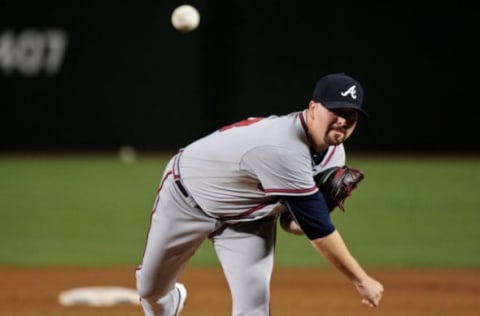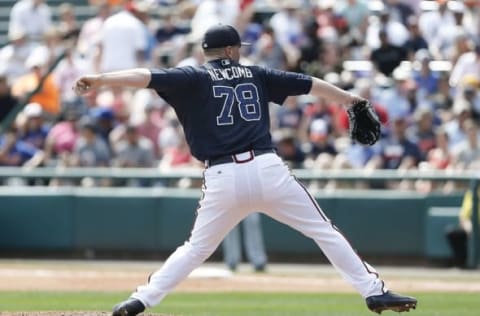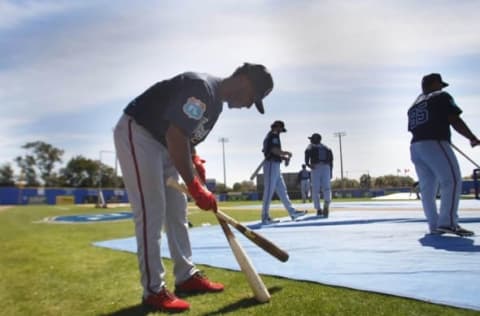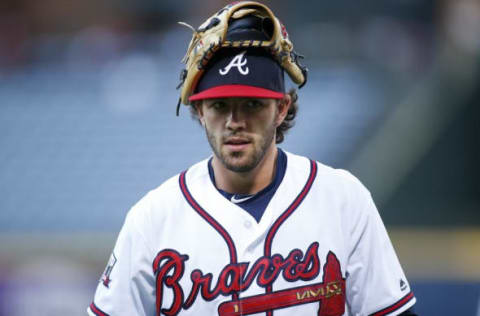Atlanta Braves 2016-2017 Top 100 Prospects: Top Ten


The Atlanta Braves have an incredible farm system, and Benjamin Chase has taken up Tomahawk Take’s minor league coverage of that system. This is his top 100 prospects in the Atlanta Braves system!
An Introduction
This is my second undertaking of an Atlanta Braves Top 100 Prospects list.
I will be honest – it was much tougher this season. Last year, I did consider just under 150 names that I considered as worthy of being on the top 100 list, but the qualifications were basically “did not look bad statistically” or “heard at least one positive thing”.
This year I knew was going to be much deeper, so I upped my personal requirements even for consideration, and I had 173 names on the initial list that I made to start sorting out from.
First, the methodology. This list is not a list of the guys who have the most talent from 1-100 as that wouldn’t tell us what we really want to know. This is an evaluation of who has the talent, the mental makeup, and the work ethic to turn their talent into a major league baseball player.
The reality is that of these 100 players, the Braves would be doing exceptionally well if 25 of them played more than a brief stint with the major league club. That part does need to be kept in mind as we continue through this list.
That does not mean that someone who is a #98 on this list can’t have a major league career. What I look at is the level of impact a player will have IF he does make the major leagues. A guy who will be an impact hitter or not make it at all will likely get rated higher than a guy who won’t make it as a starter or a late-inning reliever, but he has a good shot to be a major league middle reliever.
All players who have not exceeded rookie requirements are eligible for this list, even if they’ve played in the major leagues already.
I will have a post on Friday after the entire list is revealed that presents the list in a pure list format with no evaluation on each player for reference in the future. These posts will have more in-depth evaluation of each player in the list.
I also intend to update this list sometime before spring training begins with any off season acquisitions that the Braves make, so I won’t be updating the list as each trade/rule V pick/waiver claim is made, it will all be at that time.
With that said, let’s take a look at this post’s focus, #1-10 on the list!
Next: #10 & #9

10. Robert Whalen, RHP
Whalen is the guy that was forgotten about last season, but was originally considered the better prospect received in the 2015 annual “rob the Mets of pitchers for Kelly Johnson” trade that also brought over John Gant.
Whalen had really never been healthy as a pro, and he only made three starts with Carolina after being acquired in 2015 before getting knee surgery done to finally get himself healthy.
He spent all offseason rehabbing and getting himself healthy, and he came back with all of his stuff working well, but most impressive, he showed an incredible mental make up that is probably the most impressive in the system.
Whalen works with a four-pitch mix that plays to a six-pitch mix. He offers a four-seam and two-seam fastball. His two-seam has excellent sinking movement that really baffles hitters, getting a lot more swings than you’d expect from a sinker and rarely getting squared.
His slider has incredible depth, so much so that many places have often rated it as his best pitch, but they’ve called it a curve due to the tremendous depth he gets on the pitch. He also throws his curve with two different grips. Interestingly, one gives the traditional looping slow curve effect, and the second gives more of a traditional slider look with more of a short, sharp break, but it definitely has loop ahead of the plate like a curve.
His change emulates his four-seam fastball more than his two-seam, but interestingly, that actually plays well. Hitters expect his four-seam fastball as an eye-level-changer, and Whalen does often use it up in the zone to get hitters from looking low, low, low, where he locates everything else. Then he’ll get a hitter thinking anything high is a four-seam and he’ll toss a change there and have the hitter looking foolish as he spins himself into the dirt he’s so far ahead of the pitch.
What makes Whalen so incredibly impressive is that he has what I would grade as 80-grade mental make up. He uses his different shapes of his pitches to set up hitters within an at bat, and then when he sees that hitter the next time, he attacks him in a different way to really keep him guessing. The crazy part is that when he sees that hitter the next time, he then attacks him with a completely different game plan than the first game.
Whalen also seemed to really work well with his catchers and called out his catchers to him to set up things well and discuss working over hitters. I know this is a name that strikes a certain chord in Braves country, but I haven’t seen a guy who was this in tune with his plan of attack on each hitter since watching Greg Maddux work in the mid- to late-90s.
Whalen didn’t have a pretty showing in Atlanta, and sadly, many fans only know him from that performance, but at that point, he had already thrown 30 more innings than he’d ever thrown in his career, and he was on fumes. Heck, he was on fumes when he got to Gwinnett, let along Atlanta!
I think Whalen’s a guy that may not have a fastball that touches triple digits, a curve that makes you curse at the screen, a slider that wobbles a hitter’s ankles, or a change that a hitter pulls the Bugs Bunny effect on, but his mental make up makes all that stuff, which is all above-average stuff on its own, play up even more.
My biggest worry for Whalen is just that he works with a coach and catcher that work with him to develop his attack plan on hitters rather than preach to him a certain style or force a certain method onto him.
Whalen should be a very good candidate for a big league opening day starting rotation job, and if he isn’t in the opening day rotation in Atlanta, he’ll be a big piece of Gwinnett’s rotation.
9. Mike Soroka, RHP
I love having Soroka and Whalen back to back as they are really similar style pitchers, albeit with different methodology. Soroka is more of a traditional pitcher in his pitches, but he attacks hitters with control, working for weak contact from hitters rather than trying to overwhelm anyone with pure, raw stuff.
Soroka has excellent control, and his sinking stuff has tremendous effect, especially in limiting home runs, allowing 3 total in his 177 minor league innings thus far in his career.
Soroka did pitch nearly the entire season at 18 years old, and there were some signs of immaturity when Soroka wanted to blow by a hitter rather than get him to roll over something low in the zone.
He worked into his method as the season wore on, and his performance in the playoff showed just how far he’d come in his approach. In his two playoff starts, he threw 14 2/3 innings with a 0.61 ERA and 1.02 WHIP, with a 1/10 BB/K ratio.
He was working hard in the playoffs at getting hitters to hit the ball weakly, and his defense let him down badly. While he only allowed one earned run, his first start, he allowed 5 runs overall, and 4 of those were unearned as the defense kicked the ball around. However, Soroka continued with his method rather than attempting to take over guys on his own, sticking to the plan of getting guys to roll over pitches and letting his defense get him out of innings rather than trying to overpower hitters.
Soroka has excellent stuff overall, but it’s not the type of premium velocity of wicked snap that some guys have to get lots of strikeouts, and he’ll likely settle in as a future #2/#3 starter, but he also has a very high floor as a back-end pitcher in a rotation.
Soroka will pitch most of 2017 at 19 years old, and he will likely do it at high-A unless he forces the issue to AA during the season.
Next: #8 & #7
8. Ian Anderson, RHP
When the Braves called his name #3 overall in the draft, many were wondering exactly how the Braves were this sold on Anderson’s stuff and pitches. By the end of the season, he was being considered as the #2 or #3 overall prospect from the 2016 draft class, in spite of being a fairly drastic underpay at the #3 draft selection.
Anderson turned 18 in May of this year, so he’ll open next year at 19 years old. He’s a guy who many were not very versed on pre-draft due to his injuries and illness in his spring season, so many didn’t see him throw much in the March/April time frame when most teams are scouting high schoolers heavily.
The Braves stayed in on Anderson, and they were at his May starts heavily, sending a number of guys from their draft prep meetings to an Anderson start at one point in late May. I began hearing from many scouts how impressed the Braves were with Anderson, and they were certain he would be going to the Braves at either #3 or #40.
Anderson’s fastball plays to an elite velocity, touching upper-90s with movement, and he throws an incredible change for a teenager. I’ve also seen and heard very good comments about his curve with both the change and curve receiving plus grades.
Anderson threw well at Danville and could certainly end up assigned to Rome to start 2017, and I’m quite eager to see how he handles the workload!
7. Max Fried, LHP
Fried was returning from Tommy John this year, and it was going to be something to watch as he regained his velocity. He certainly gained all of his velocity back and then some. His top end velocity of 97ish MPH was there with bite, and some said he added velocity on his slider, giving it harder, more distinct break.
Adam Wainwright has said that in returning from TJS, a pitcher will regain his velocity in his first year back on the mound and his command in his second year back. Fried certainly regained his velocity and then some in 2016. 2017 should see that command.
Except that we already got a preview. As the season finished, Fried was on a tear, spotting his curve and slider in ways to generate a ton of swinging strikes. His final three starts of the season, Fried threw 16 2/3 innings, and while he did allow a 4.32 ERA, he also allowed only 5 walks and struck out 26 hitters, rates of 6.8% walk and 35.6% strikeout.
Then in the playoffs, Fried was called on to close out both the semifinal series and the championship series. Combined, he threw 14 2/3 innings, with a 1.23 ERA, 0.75 WHIP, and a 4/24 BB/K ratio in the two starts. He was spotting his pitches with command that he’d not exhibited in June and July for certain.
Fried has legit ace-level stuff, but he is 22 and will be 23 in January, so it wouldn’t surprise me if he’s pushed up to AA to start 2017 to challenge him and push along his development.
Next: #6 & #5
6. Kevin Maitan, SS
Braves fans have been hearing all about Maitan since he was about 13 and was working with a scout that had a good relationship with the Braves. He was rumored to have skills that no one had seen in the international market since Miguel Cabrera, certainly since Miguel Sano was an amateur.
Maitan is a switch-hitter with natural power and excellent contact skills that has a good idea of the strike zone. He also displayed a high baseball IQ in tournament play, making very heads-up plays that a typical young player would not know to do.
Maitan was considered a longshot already to stick at shortstop with his wide frame and plenty of growth left to do, but he showed up at instructs with guesses on his size anywhere from 6’3-6’5 and size estimates of 190-215. That’s simply huge for a kid who won’t be 17 until February.
Maitan will likely profile at third base, but he has extremely smooth actions defensively with a potential plus arm and very solid instincts. I’m curious how the Braves will handle Maitan in 2017, whether they start him with GCL or jump all the way to Danville.
5. Ronald Acuna, OF
Acuna was a guy who I kept bumping up in rankings last offseason, settling in my January rankings with him inside the top 20, which is extremely high praise for a guy who wasn’t an elite signee off his first year of pro ball.
Acuna in his first pro season split between GCL and Danville, hitting .269/.380/.438 with 4 home runs and 16 steals and a 28/42 BB/K in 237 plate appearances. That earned him a trip to Rome this year, and he came out of the gate looking like a guy who should be a top-100 overall prospect in the game without question before a wrist injury kept him out until mid-August.
Acuna has incredible raw power that he’s growing into. His swing shows power that would rate to me as a 65 future value grade once he builds into his frame.
On the 2016 season, Acuna hit .312/.392/.429 with 4 home runs and 14 stolen bases with a 19/29 BB/K over 179 plate appearances.
Acuna has elite offensive talent, but what will decide his future talent will be his defensive value. The team played him exclusively in center field. Acuna has solid instincts in center, but he’s not the rangy guy that Ray-Patrick Didder or Cristian Pache are in center field. Acuna does have a very solid arm. I’d say he’s probably a guy who plays well in either corner, but probably profiling as an elite defensive left fielder and above-average right fielder.
Acuna will be interesting to see how he’s handled. He only had 40 games with Rome, so not sure whether he will be sent to high-A or returned back to Rome.
Next: #4 & #3
4. Kolby Allard, LHP
After back issues caused Allard to miss some time in his high school senior year before being drafted 14th overall in last June’s draft. After his back issues were resolved, the Braves were very careful with his pro workload, only allowing him to throw 6 innings in rookie ball.
Allard was going to be allowed to show if he could handle Rome by his performance in spring training and extended spring training. He did show he was healthy and ready to go, so he was sent up to Rome in early June, but the results weren’t pretty whatsoever, as he made three starts, totaling 12 innings, with a 8.25 ERA and 1.67 WHIP and a 4/12 BB/K ratio.
He was sent back to extended spring and then started the season with Danville when their season started. His time with Danville was impressive to say the least, as he put up a 1.32 ERA and 0.84 WHIP over 27 1/3 innings with a 5/33 BB/K ratio.
He was promoted to Rome, and it was a much different story. His command was better, and more importantly, he was working with his coaches and following their sequencing. He made 8 regular season starts, allowing a 2.61 ERA and 1.12 WHIP while posting a 16/50 BB/K over 48 1/3 innings.
In the playoffs, Allard really showed his excellence, making two starts with 12 innings and not a single run allowed and a 1.00 WHIp, posting a 3/10 BB/K ratio.
Allard has a fastball that can touch mid-90s, an excellent change, and his best breaking pitch is a curve that gets plenty of swing and miss. He showed much, much better command and control of his pitches as the season wore on, and I’m sold on his ability to be a top-end guy.
Allard will be sent to high-A most likely to start 2017. I’d expect him to spend the entire season there as he won’t turn 20 until late in the year – that is, of course, unless he drastically shoves in Florida State League.

3. Sean Newcomb, LHP
“Nuke” was the prime prize from the Andrelton Simmons trade last offseason. He was a cold weather starter from Massachusetts that attended the University of Hartford in Connecticut. His arm was very untaxed when he was drafted in the first round of the 2014 draft.
The Angels handled Newcomb lightly in 2014 and 2015, easing him to 136 innings in 2015. He finished in AA. Many were looking for Newcomb to make a move to AAA in 2016 or to at least make a big improvement in his control in 2016.
Many would see the results that Newcomb had in 2016 as a disappointment, but a closer look at what he was doing would show some impressive growth. Newcomb was making adjustments on the fly in his delivery in order to make it more repeatable. He was also working to attack the zone low with his fastball and change early, using his excellent breaking pitches to put away hitters.
Newcomb shifted his stance on the rubber in July, and it was obvious that he took time to adjust to this. He looked much different on the last start of the month, July 30th. His previous 5 starts in the month had 21 2/3 innings with a 7.48 ERA, 1.75 WHIP, and 18/21 BB/K. If you take out those 5 starts from the season line, Newcomb’s season stat line would be a 3.19 ERA and 1.23 WHIP with just barely short of a 10 K/9 rate. That sort of season would have people drooling.
I’m not saying that those starts didn’t happen by any means, but it’s a good idea to take a look at what is behind a guy’s rough patches before making any assumptions.
Newcomb has a fastball that can reach mid-90s with ease. He throws a curve that makes hitters completely buckle. His pitch mix is such that he has absolute “ace” upside.
Newcomb will likely be seeing AAA Gwinnett to open 2017. His progress he made in 2016 in working over hitters will hopefully push him to the major leagues within the 2017 season.
Next: #2 & #1

2. Ozzie Albies, 2B
More from Tomahawk Take
- Atlanta Braves 2012 Prospect Review: Joey Terdoslavich
- Braves News: Braves sign Fuentes, Andruw’s HOF candidacy, more
- The Weakest Braves Homers Since 2015
- Atlanta Braves Sign Joshua Fuentes to Minor League Deal
- Braves News: New Year’s Eve comes with several questions about the 2023 Braves
To be 100% honest, before his unfortunate injury, Albies would have easily been my #1 overall guy. He played the entire season at 19 years old (and doesn’t turn 20 until January). Combined between AA and AAA, he hit .292/.358/.420 with 10 triples, 6 home runs, and 30 stolen bases, posting a 52/96 BB/K over 618 plate appearances.
Albies showed this season the power that many have said was in his compact swing. He is only 5’9 (if even that!) and built fairly slender, but he has an explosive swing that leads to plenty of power, but he just hadn’t produced a ton of balls over the fence before this season.
Albies did struggle upon his promotion in late-April to AAA Gwinnett, but once he moved to 2B with Gwinnett, his bat started to pick up there, as he finished out hitting .267/.350/.347 with 3 triples and 6 stolen bases in his last 25 games at AAA before moving back down to AA to play alongside Swanson.
Albies has an elite contact ability, tremendous running ability, and an incredible defensive range. The biggest concern for Albies would have been his size and how real his power he displayed in 2016 was…until his injury.
Now, we should see Albies sometime in spring training back on the field. Hopefully, he is able to get onto the field in time to compete for an opening day job with the big league club, but even if not, he shouldn’t take long to work his way up to the big leagues.

1. Dansby Swanson, SS
Without Albies injury, Swanson would be #2, but that’s no knock on him by any means. Swanson is arguably a top 10-15 prospect in the entire game right now, so to be beaten out takes a pretty elite player.
Swanson has more than just the hair tool. He also is tremendous on the field leading the team. I heard about his leadership from many who compared him to Jeter for that reason, and I honestly passed it off as one of those flowery things that someone says. Then I watched Swanson take the ball from the pitcher and calm a struggling guy down so he could get out of an inning. I watched him yell out instructions as a ball came in from the outfield so everyone was in the position they should be in. He was the quintessential quarterback on the field.
Swanson isn’t just immeasurables, though. He has excellent patience at the plate, the ability to make solid contact, above-average power and speed, and an excellent defensive profile. Frankly, take the profile of Whalen on the mound and translate it to Swanson. He doesn’t have a single tool that is elite really, but his mental makeup makes all those above-average tools play up into an elite player.
Oh, and the hair.
Next: Braves Minor League Database
I hope you enjoyed this series! I’ll have a post tonight with just the list for a reference point, but no analysis on that post. Definitely look forward to more scouting reports this offseason and the update that will likely come when prospects are acquired!!